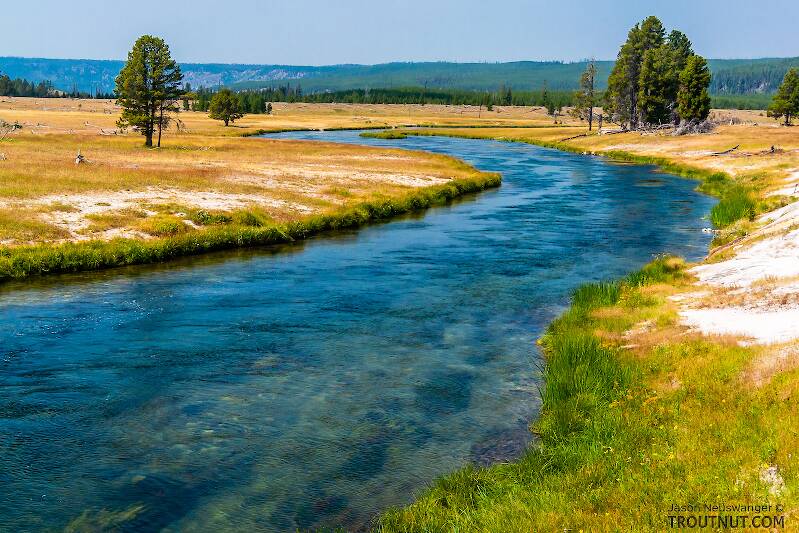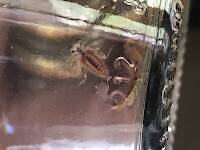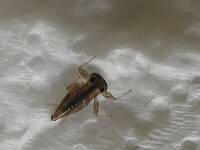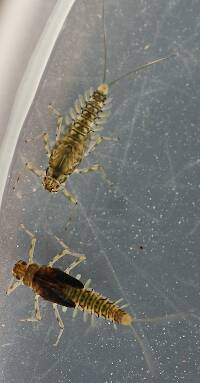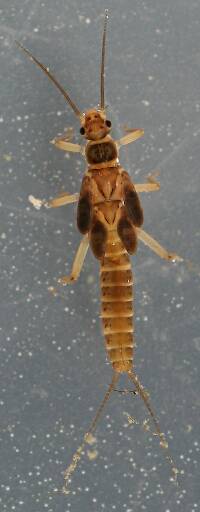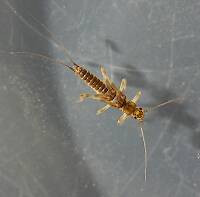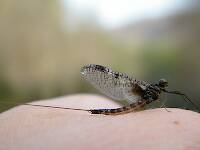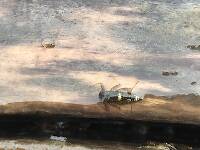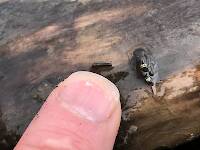
Blue-winged Olives
Baetis
Tiny Baetis mayflies are perhaps the most commonly encountered and imitated by anglers on all American trout streams due to their great abundance, widespread distribution, and trout-friendly emergence habits.
Featured on the forum

This specimen appears to be of the same species as this one collected in the same spot two months earlier. The identification of both is tentative. This one suffered some physical damage before being photographed, too, so the colors aren't totally natural. I was mostly photographing it to test out some new camera setting idea, which worked really well for a couple of closeups.

Troutnut is a project started in 2003 by salmonid ecologist Jason "Troutnut" Neuswanger to help anglers and
fly tyers unabashedly embrace the entomological side of the sport. Learn more about Troutnut or
support the project for an enhanced experience here.
Redacted
Posts: 5
Posts: 5
Redacted on Feb 14, 2011February 14th, 2011, 4:07 am EST
Bitterroot River near Missoula, Montana. Late March emergence.
PaulRoberts on Feb 14, 2011February 14th, 2011, 6:21 am EST
That early? Very cool.
Redacted
Posts: 5
Posts: 5
Redacted on Feb 15, 2011February 15th, 2011, 6:14 am EST
Paul,
Ment to put up a photo for people to ID, but for some reason can't get it to work before the post floats away.
Anyway, yes, this early mayfly provides some of the very best fishing of the season. It is big enough (well matched with a #14 although it looks larger floating on the surface) and numerous enough to move the fish to a frenzy sometimes.It generally follows the famous Skwalla emergence, although there is considerable overlap. Once runoff starts in ernest, though, the fun is over.
An article I wrote for Tom Chandler's Troutunderground.com blog last spring has pictures of Skwallas copulating (note the atrophied wings of the male) and a really nifty picture of the mayfly in question.
Just do a search for "Sully" and look for that post to see those pictures since I'm too stupid to figure out how to do it directly.
Ment to put up a photo for people to ID, but for some reason can't get it to work before the post floats away.
Anyway, yes, this early mayfly provides some of the very best fishing of the season. It is big enough (well matched with a #14 although it looks larger floating on the surface) and numerous enough to move the fish to a frenzy sometimes.It generally follows the famous Skwalla emergence, although there is considerable overlap. Once runoff starts in ernest, though, the fun is over.
An article I wrote for Tom Chandler's Troutunderground.com blog last spring has pictures of Skwallas copulating (note the atrophied wings of the male) and a really nifty picture of the mayfly in question.
Just do a search for "Sully" and look for that post to see those pictures since I'm too stupid to figure out how to do it directly.
PaulRoberts on Feb 15, 2011February 15th, 2011, 7:02 am EST
Put your images in a host site, like Photobucket, and then copy it in.
Use the
(User tried to post an image here without an source.)
format, but for this site you need to change the IMG to lower case -img.

changes to:

Why do you think it's Ameletus? It looks like a bright Rhithrogena morrisoni. Have you keyed it? Hind wing is large like Rhithro. And the abdomen appears pretty short, for Ameletus. Not certain of course, just wondering.
I do have an Ameletus dun photo in my collection, but it's a transparency. I tried to take a point-n-shoot of it, but the result was just lousy. It's an eastern species (ludens I think) and the stamp on the slide is April(!). They do have a long emergence period -like all summer. I guess I forgot how early they can start. It is a leaden gray throughout, including wing. Looks a lot like a slim Siphlonurus, and a lot like an Isonychia.
At least some western Ameletus have marked wings from what I've read, and I tried to photo one last summer, with marked wings -and almost succeeded! I was keeping my eyes open for them and had one land on my hat brim. Did look like a slim Rhithro. Will keep my eyes open in the future.
Use the
(User tried to post an image here without an source.)
format, but for this site you need to change the IMG to lower case -img.

changes to:

Why do you think it's Ameletus? It looks like a bright Rhithrogena morrisoni. Have you keyed it? Hind wing is large like Rhithro. And the abdomen appears pretty short, for Ameletus. Not certain of course, just wondering.
I do have an Ameletus dun photo in my collection, but it's a transparency. I tried to take a point-n-shoot of it, but the result was just lousy. It's an eastern species (ludens I think) and the stamp on the slide is April(!). They do have a long emergence period -like all summer. I guess I forgot how early they can start. It is a leaden gray throughout, including wing. Looks a lot like a slim Siphlonurus, and a lot like an Isonychia.
At least some western Ameletus have marked wings from what I've read, and I tried to photo one last summer, with marked wings -and almost succeeded! I was keeping my eyes open for them and had one land on my hat brim. Did look like a slim Rhithro. Will keep my eyes open in the future.
PaulRoberts on Feb 16, 2011February 16th, 2011, 6:27 am EST
Another thing: Look at the width of the femur. That's Rhithrogena.
Entoman on Feb 16, 2011February 16th, 2011, 7:11 am EST
Hi Redacted,
Paul is right. They usually appear darker, but lighting in the photo could be the reason for that. Ameletus is a large swimmer whereas Rhithrogena is a clinger. Keys aside,the body and wing conformation is very different between the two (as are the fishing methods and flies required). Both share similar coloration and mottling (or lack of) and can be easily confused depending on the angle and quality of the photograph. But even without a photograph, the real clue is your mention of hatching in the early Spring. Skwalas and W. March Browns are two favorite hatches on one of my local rivers (mid FE through MA). The lack of precip. in JA and early FE was setting up a banner year! I was just getting geared up and now its starting to rain... Much higher levels and off color to flat out muddy if it goes on much longer! Supposed to be socked in all week which is dimming my hopes for this years Skwala/M. Brown tag team. Once the storm window opens out here it can last for weeks....(sigh) Check out my comments on Skwala, you might find them enteresting... BTW, great photo of the March Brown! Can you share some photos of the Skwala Adult/Nymphs from your river if you have them?
Best regards,
Kurt
Paul is right. They usually appear darker, but lighting in the photo could be the reason for that. Ameletus is a large swimmer whereas Rhithrogena is a clinger. Keys aside,the body and wing conformation is very different between the two (as are the fishing methods and flies required). Both share similar coloration and mottling (or lack of) and can be easily confused depending on the angle and quality of the photograph. But even without a photograph, the real clue is your mention of hatching in the early Spring. Skwalas and W. March Browns are two favorite hatches on one of my local rivers (mid FE through MA). The lack of precip. in JA and early FE was setting up a banner year! I was just getting geared up and now its starting to rain... Much higher levels and off color to flat out muddy if it goes on much longer! Supposed to be socked in all week which is dimming my hopes for this years Skwala/M. Brown tag team. Once the storm window opens out here it can last for weeks....(sigh) Check out my comments on Skwala, you might find them enteresting... BTW, great photo of the March Brown! Can you share some photos of the Skwala Adult/Nymphs from your river if you have them?
Best regards,
Kurt
"It's not that I find fishing so important, it's just that I find all other endeavors of Man equally unimportant... And not nearly as much fun!" Robert Traver, Anatomy of a Fisherman
Quick Reply
Related Discussions
Topic
Replies
Last Reply
0
Jul 15, 2011
by Bnewell
by Bnewell
4
Apr 10, 2020
by Konchu
by Konchu

